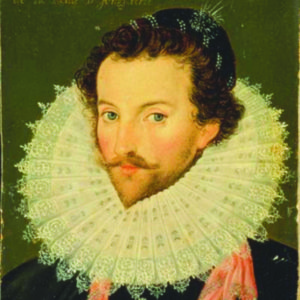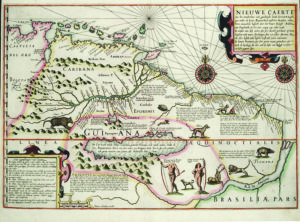By Dr. Odeen Ishmael
Shortly after Raleigh left the Guyana region, soldiers from the Spanish settlement of Cumaná, west of the Orinoco, were sent to apprehend the two Englishmen Raleigh had left behind. They managed to hold only one of them named Francis Sparry; the other had been killed and eaten by a jaguar. The young Englishman, and the Amerindians with whom he resided, informed the Spanish soldiers that Raleigh was expected back in March 1596.

In 1596, Raleigh sent his lieutenant, Lawrence Keymis, back to Guyana in the area of the Orinoco River, to establish contact with the two Englishmen and the Amerindians there and to gather more information about the golden city. It is not known if he learned of the whereabouts of the Englishman whom the Spaniards held. But he did describe the site of a village (which became the Spanish settlement of Santo Thomé) as a “ranceria of some twenty or thirty houses at the mouth of the Caroli”.
During his exploration of the coast between the Amazon and the Orinoco, he visited 52 rivers and claimed discovery of 40 of them. In addition, he mapped the location of Amerindian tribes and prepared geographical, geological and botanical reports of the country. He also sent one of his captains, Leonard Berry, to explore the Corentyne River which he did until he was stopped by rapids on that river.
In his report, Keymis expressed the view that Manoa could be reached by way of either the Corentyne or the Essequibo rivers. His report named “Lake Parima” as the location of Manoa, and shortly after, cartographers in Europe actually showed the location of this lake and city on their maps of the Guyana region. (One version of his report fixed the city of Manoa somewhere between the sources of the Essequibo and the Rupununi Rivers on a “Lake Roponowini”).

Queen Elizabeth I died in 1603 and was succeeded by James I who immediately established peace with Spain. Many favourites of Elizabeth were dismissed from high office, and Raleigh was soon after accused of being part of a conspiracy to assassinate the king. He was imprisoned in the Tower of London until 1617 when he managed somehow to convince King James to allow him to return to Guyana to search for the golden city. The King most likely gave his permission because he hoped that any acquired treasure would help to finance royal projects. However, the King warned him not to provoke any clashes with the Spaniards with whom England was at peace.
Raleigh set sail with 14 ships and 500 men and finally cast anchor near the mouths of the Orinoco. From here he sent his lieutenant Keymis with an expeditionary force up the river.
By this time, the Spanish Governor of Trinidad, Antonio de Berrio, had strengthened the defences of the small settlement of Santo Thomé on the lower Orinoco aimed at blocking any encroachment by non-Spanish expeditions. The Spaniards tried to prevent Keymis and his men from passing the settlement, but using superior force, the English destroyed it and proceeded upstream. Unfortunately, in the fighting, Raleigh’s son was killed. From Amerindians they met, Keymis was unable to obtain any information of the golden city and eventually reported his failure to Raleigh. Angry words were exchanged between them over the death of Raleigh’s son, and Keymis, probably in remorse, committed suicide.
After an unsuccessful stay of 26 days, the expedition returned to England. Meanwhile, the action of the English in destroying San Thomé was reported to James I by the Spanish authorities. Raleigh was blamed for this unfriendly act and was, immediately on arrival back in England, imprisoned on the charge of treason. He was beheaded in 1618 to give satisfaction to the Spanish King. (“The Guyana Story – From Earliest Times to Independence” By Dr. Odeen Ishmael) (Guyana Times Sunday Magazine)



